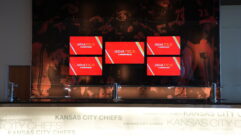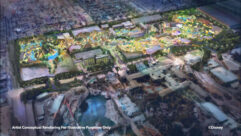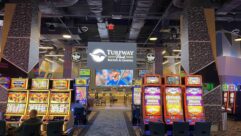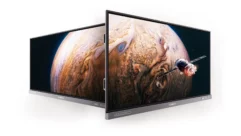

Livestrong Sporting Park: Wired for Action in Kansas City
Apr 5, 2011 2:35 PM,
by Dan Daley
Intricate coordination among audio, lighting, IT, and architecture gives Major League Soccer a new jewel
Livestrong Sporting Park
They started out as the Kansas City Wiz and became the KC Wizards. But as of this, the Major League Soccer team’s 16th season, the newly rebranded Sporting Kansas City will have a new stadium to call its own. The team’s new home, the Livestrong Sporting Park, may be rather emotionally named—Sporting KC will give a portion of fan revenue to the Lance Armstrong Foundation charity—but its AV systems are as good as they get. The end zones of the 342,000-square-foot arena, which will hold 18,500 for games and 25,000 for concerts and other entertainment events, are bookended by Panasonic video displays, an 84’x24’ one at the south end of the field and a 42’x12’ display at the opposite end, both comprised of Panasonic 16mm JL16 LED modules. The field is wrapped on three sides by 30in.-high Panasonic LED ribbon boards, calculated to keep the advertising content always on-camera. Based on that, the stadium bills itself as the first MLS arena to have lighting specifically designed for HDTV. The stadium’s sound system is based on the EAWAX and MX series enclosures.

Livestrong Sporting Park is the first MLS arena to have
lighting specifically designed for HDTV.
“All of the systems’ components are important to each respective aspect of the stadium’s AV,” says Brian Elwell, senior consultant at Acoustic Dimensions, which designed the sound and video systems, “but it was the coordination between them that was the real story. The stadium’s systems were extensively modeled in 3D, and it’s fair to say that just about every component—every speaker and every light fixture—had to be moved to some extent or another, up, down, left, or right, to make everything fit perfectly and not interrupt the aesthetic look of the stadium,” he recalls. “It had to look like it was all designed as a single entity and it was a pretty intense process.”
Acoustic Dimensions’ speakers, the sports lighting design by M-E Engineers, the structural design by Thorton Tomasetti, and Populous’ architectural design were ultimately all imported into Autodesk’s Navisworks. That began a series of tactical moves intended to keep all designs as intact as possible without interfering with each other or the stadium’s visual lines. The project’s general contractor, Turner Construction, coordinated the process. “The team did a great job in the overall design,” says Elwell. “Nothing simply ‘hangs’ anywhere—it’s all aesthetically integrated. So all the subcontractors had to work to maintain that same level of fit and finish.”

The sound system
features EAW AX and MX series speakers.
For the distributed sound system, that meant most of the several hundred speakers in the system had to be moved; sometimes as little as a few inches, sometimes more radically. An example of the latter: the original design had a single speaker array at every other truss consisting of three full-range AX 366 boxes and a custom subwoofer, but had to be split so that two of the boxes became aimed for front firing and the third aimed to the rear, while the sub was moved to the other side of the main truss. Additionally, the subwoofer size was altered by using a customized KF850-based subwoofer in lieu of the originally designated KF1000-based model. “The required curvature of the array, the height of the array, and the depth of the subwoofer were interfering with the aesthetics and the sports lights, and the 3D model clearly exposed those conflicts.” Elwell explains. The asymmetrical swirl-shaped roof compounded the design. As the roofline got lower, the design had to be modified to decrease the spacing between speakers. That in turn increased the number of speakers used but also required that their level be set accordingly lower, as well. The BSS Soundweb London DSP BLU-160 units, whose processing was distributed on a per-speaker basis, would handle that. “Localizing the DSP processing also meant that we weren’t locking the system to single-point failure,” says Elwell.
A Fast Track Late In The Game
The systems’ integrator, Progressive Electronics, installed the sound system and much of the video systems. They had to carefully integrate the technology as well as keep pace with the incredibly fast schedule, which made this an unprecedented project. The accelerated schedule presented challenges in every aspect, which forced them to rethink the normal construction process. Products were changed to ensure timely arrival, site condition issues had to be resolved expediently, and coordinating crews had to work in conjunction
Livestrong Sporting Park: Wired for Action in Kansas City
Apr 5, 2011 2:35 PM,
by Dan Daley
Intricate coordination among audio, lighting, IT, and architecture gives Major League Soccer a new jewel

The two videowalls at Livestrong Sporting
Park are comprised of Panasonic 16mm JL16
LED modules.
The contractors weren’t the only ones who felt the time pressure. EAW had to expedite the fabrication process in order to meet the early January installation deadline for the canopy speakers. This was in order to allow the field grass to be installed with enough time to take root. Progressive had a small window of time from the delivery of the speakers until they were to be installed. For the audio system, coordination of the exact speaker locations was just the first step in the process. Next was properly matching the colors to maintain the aesthetics of the seating canopy. Speakers that were set in front of the canopy had to be a light bluegray color, while speakers mounted on a truss needed to be a matching dark blue.
The third step in the speaker installation process required Progressive to create solutions for mounting in some of the more difficult locations. For the clusters that consisted of three EAW AX366-WP enclosures, that meant creating a steel mounting bracket that would straddle the 14”x6” purlins (horizontal structural members in a roof that support the loads from the roof deck or sheathing and are supported by the principal rafters and/or the building walls, steel beams, etc.) that support the roof structure. A steel saddle was developed that sat astride the purlins, offering hangars for the front and rear elevations of the mini-line array clusters.
Weather Issues

Workers assemble the 84’x24’ videowall on the south end of the stadium.
As if the accelerated schedule was not enough, the soccer stadium was under construction during one of the worst winters on record in the Midwest. In fact, Craig Metzler, president of Progressive, figures it was to Progressive’s advantage to adhere to the mid-January timeline for speaker installation, since it helped get them in before the worst of the snows hit well into February. Using a 130ft. crane to lift PA segments into place, rather than manpower and pulleys, was a smart decision. “At that time the roof was not complete, so we were able to drop things into place instead of having to push them up into place,” says Metzler. “We had gravity working for us instead of against us.”
Another tactic that helped in the face of inclement weather was Turner Construction, the project manager on the stadium, to let Progressive store its fiber cabling in heated storage areas around the work site, rather then leave it out to the elements before installation. “Otherwise, it would have been brittle and harder to work with and that would have slowed us down,” he says.
Sporting Kansas City’s $200 million stadium, along with other planned construction on the site, is expected to generate 8,300 jobs, attract 2.5 million visitors a year, and have an annual economic effect of $500 million, according to the Kansas City Business Journal. But by some of its systems contractors it’ll be remembered as one of the most detailed and tightest-deadline projects they’d ever worked on. “Every bit, down to the screws and the nuts, were modeled and shifted before we were done,” Elwell recalls. “And everything ultimately ended up in the right place.”










